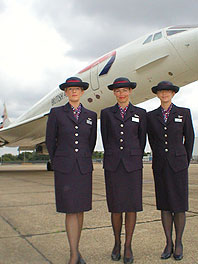|
Between 1976 and 2003, the fastest, highest flying, and most elegant
way to travel between Europe and the U.S. was aboard the
British-French Concorde, a marvel of aircraft engineering that had
to battle protestors, politicians, and nervous accountants to earn
its place in aviation history and also win the hearts of an adoring
public, including many who could never afford to fly it. In
"Supersonic Dream," NOVA explores the mystique of this technological
wonder of the world.
Among those paying tribute to the plane is former U.S. Secretary of
State Henry Kissinger, a Concorde frequent flyer with hundreds of
trips to his credit. Rock singers and movie stars were also
devotees, along with a staple clientele of elite business
executives. But Concorde was also popular with lovers, who would
typically wait until the cabin speedometer hit Mach 2—twice
the speed of sound—to pop the question.
Mach numbers were what Concorde was all about. No other civilian
aircraft could even approach its top speed of Mach 2.04, or 1,350
mph, since every other passenger aircraft flies subsonic. And for
good reason. Supersonic shock waves, wind friction, and high fuel
consumption make flying faster than sound an expensive technical
challenge.
Even so, when Concorde began to take shape in 1959, conventional
wisdom held that "speed sells seats." Industry executives expected
supersonic travel to be the logical evolution of the subsonic jet,
then being introduced. Daunted by the cost of the project, which
would eventually reach 10 times the original estimate, the British
and French governments teamed up to finance Concorde in 1962, hoping
to beat the expected American entrant, which in the end was never
developed.
NOVA examines the innovative solutions that the British-French team
devised, from the world's most efficient jet engines to the first
computer-based flight controls for a commercial aircraft. Concorde's
most distinctive feature—its elegant shape—also emerged
from the engineering demands of supersonic flight. Its long, narrow
body reduces drag, as does the cone-shaped nose, which can be tilted
down during takeoff and landing for better pilot visibility. The
delta-shaped wing provides high performance across a wide range of
speeds. (For a closer look at the plane, see
Anatomy of Concorde.)
British designer Dudley Collard points to the gracefully curved wing
tip and says proudly, "It's that shape because that was the one that
came out to be best. It's not because it was beautiful." But it is.
"Beauty is a by-product," proclaims Jean Reich, Concorde's chief
engineer. (For a former pilot's take on the plane, see
Flying High.)
Concorde's first test flight was in 1969, ironically around the same
time that the wide-body Boeing 747 was introduced. With its ability
to carry large numbers of passengers efficiently at subsonic speed,
the wide-body, not Concorde, was the wave of the future.
Concorde soon ran into another hurdle. As with all planes flying
faster than sound, Concorde dragged a big shock wave behind it
whenever it flew supersonic, creating a sonic boom as it passed.
Citizens along the projected flight path began to pressure their
governments not to buy planes and not to grant over-flight
privileges. In the mid-1970s, Concorde barely survived a campaign to
ban it from New York and Washington airports, which might have
killed the plane outright.
Instead, its daily trans-Atlantic crossings became the status symbol
to end all status symbols—"the only way you can in human life
be in two places at once," according to frequent-flying British talk
show host Sir David Frost. Plane spotters, who could never afford a
ticket, also fell in love with the graceful aircraft.
Concorde eventually succumbed to the forces of economics, to a
tragic accident in Paris that traced to a tire and fuel tank
problem, and to the destruction of the World Trade Center on
September 11, 2001, which killed a large number of the plane's best
customers. But the dream of supersonic flight lives on as a new
generation of engineers eyes the challenges of fulfilling the
vanished promise of Concorde (see
Shock Treatment).


|


|
The love affair with Concorde extended from designers to
engineers, passengers to never-to-be passengers, and
pilots to attendants, such as this British Concorde
flight crew.

|
|
|

